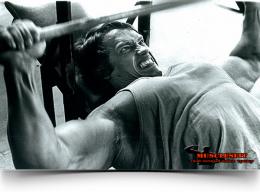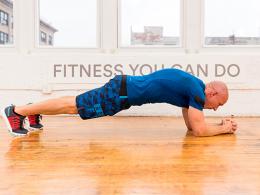How to increase bench press? We're making a breakthrough.
Greetings, my dear readers!
Have you ever wondered how to increase your bench press? If yes, then this article is for you. Today we will thoroughly analyze this basic exercise and get acquainted with specific chips that improve the “bench” performance. 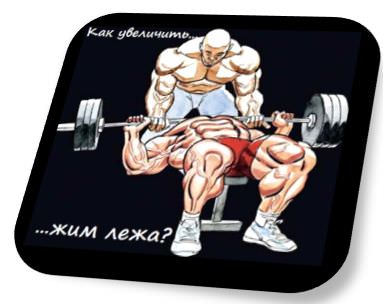
Well, the goals are set and I can’t wait to get started, let’s start.
Bench press: debriefing
I must say right away that you owe this article to me :), more precisely, to me and our American colleagues, because it was from them that I “snatched” some of the scientific and therefore even more valuable information on the issue of how to increase the bench press. Furthermore, this note should only be considered in conjunction with its predecessor, namely this one. In the latter, we consider a lot of theory and the very correct technique for performing this exercise from the “golden three” of powerlifting.
So let's start getting enlightened.
It was not in vain that I mentioned weightlifting, because it was these guys who always squeezed the heaviest weights and they own the most significant records. (see image).

All this suggests that, most likely, they understand at least something in this matter. Well, if they understand, then you need to listen to them.
Let's hit the scientific data right away and look at the typical instant identification points (movement phases) that are found in the classic bench press. (see picture).
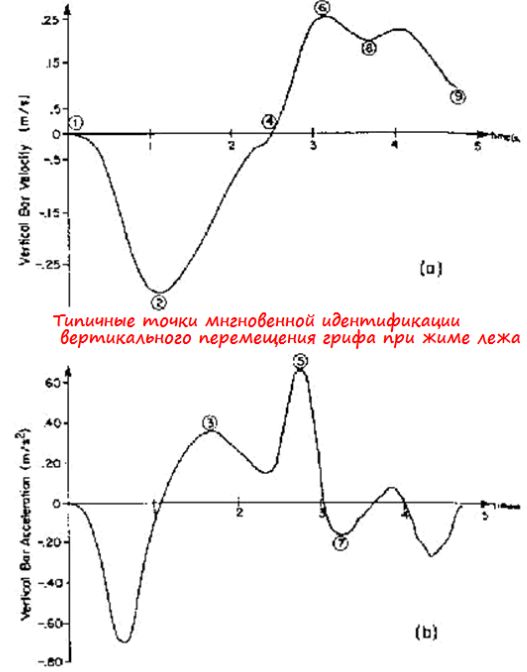
In total, the bench press can be distinguished 9 phases:
Now let's look at the phases of lifting and lowering the projectile under a microscope. And the first in line is the trajectory of the neck, the moment the bar is lowered.
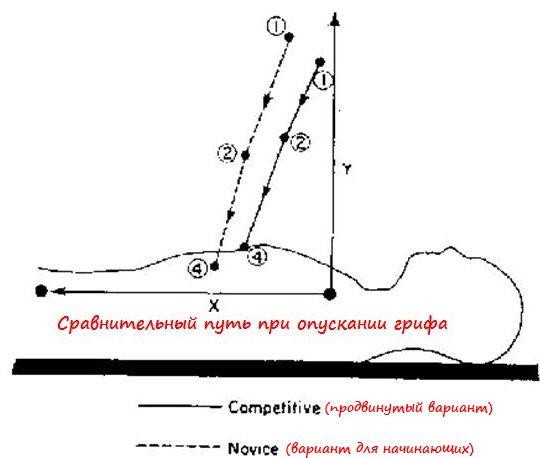
Then comes the trajectory of the neck - the moment of lifting the barbell.
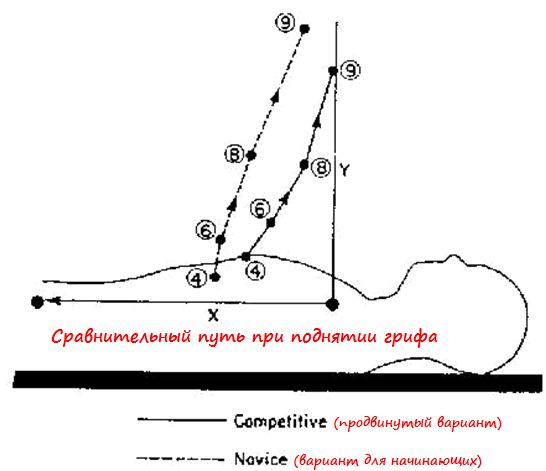
Note:
On the given charts:
- Model of neck motion during vertical acceleration (images a and b);
- Two ways of projectile movement - for an experienced and novice lifter in the bench press.
Now let's move on to the biomechanics of the bench press.
Let me remind you once again what muscles (muscle groups) participate in all phases. All eyes on the following images.
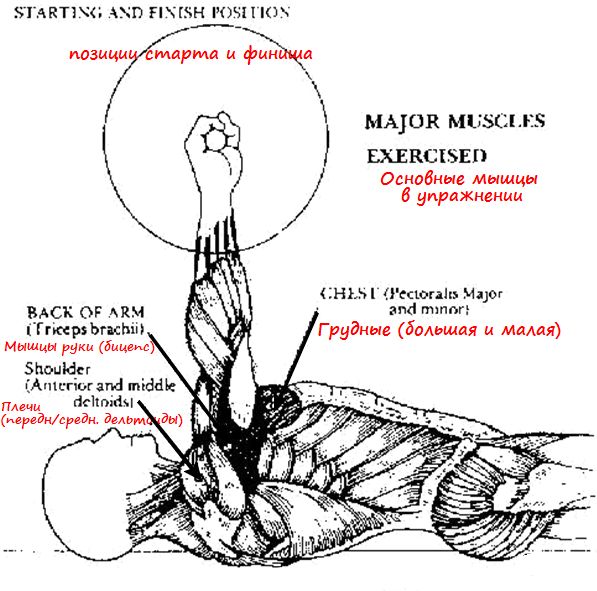
Intermediate position (near the chest).
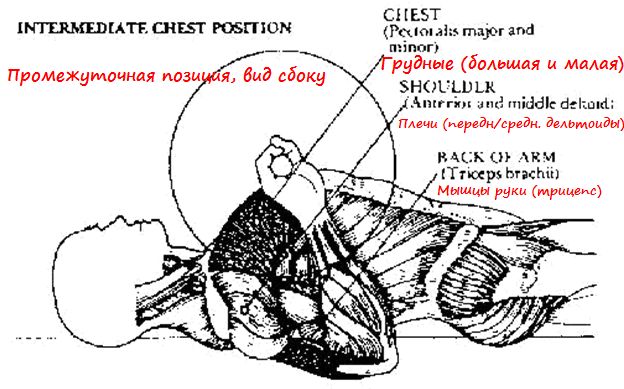
Because If we want to maximally load the muscles of the chest, shoulders, arms and achieve their most effective study, then the neck should describe an “arched” trajectory of movement. This is best seen from the side when the lifter presses the weight off the chest. (see picture). Down the neck falls along the same trajectory.
![]()
Very often, in order to squeeze more weight, athletes resort to various tricks - in particular, they stand on the “wrong” bridge.
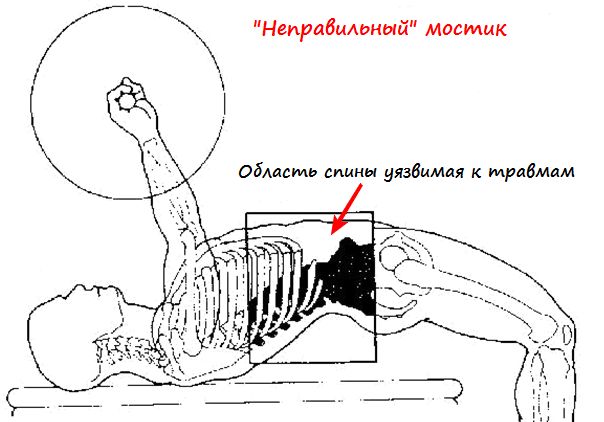
In this position, a significant area of the spine is vulnerable to injury.
I think you have noticed that very often the bench press is performed with a specific rebound from the chest. Let's see why this is happening. In general, the following reasons can be distinguished:
- projectile weight too large (A) ;
- loss of muscle control (B) ;
- the bar moves down quickly (C);
- inertial rebound from the chest (D);
- muscles perform scanty work (E).
As a result of the “bounce”, the muscles do little work, i.e. they do not receive the load intended for them in this exercise. The whole process occurs by inertia in automatic mode. During the rebound, weight is removed from the chest as a result of the simultaneous action of three factors (A, B, C).
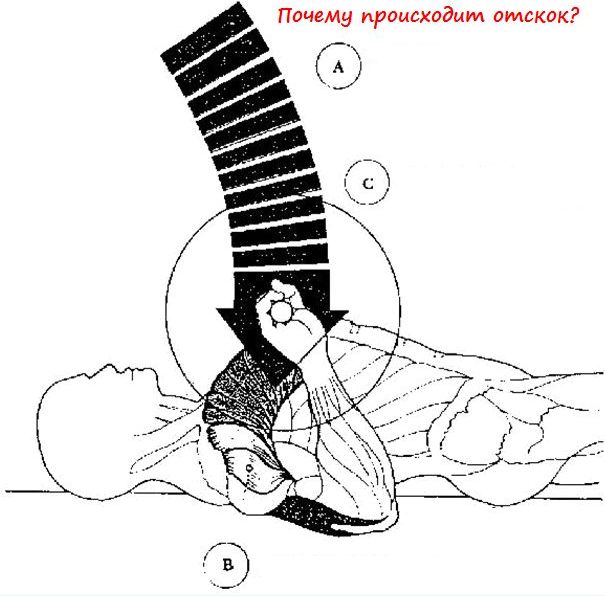
The projectile falls with all its weight on the chest, then bounces and is instantly picked up (shoulder, arm and pectoral muscles) to bring up.
I specifically decided to take a closer look at the bench press and some of the most common mistakes, because. many of them (bridge and rebound) refer specifically to the tools that allow you to increase the bench press. Well, now, after you have found out where the dog is buried :), you can move on to practical advice on strengthening the “bench presses”.
I think you know that every person is an individual. So, this is manifested not only in his character traits, “degree of sheepishness”, etc., but also in physiological characteristics, in particular, in the structure of bones (length, width) and the lag / predominance of one or another muscle group.
Therefore, it must be borne in mind that if you are a unique fruit (in terms of), then it will not be very comfortable for you to perform a bench press in its two classic versions:
- "chest" style - the shoulder sections of the arms are perpendicular to the torso;
- "triceps" style - the elbows are almost pressed to the body.
Most likely, some intermediate option is suitable for you, in particular from these (see table).

Note:
lifters (not those who monitor the elevators in the house), who have strongly developed pectorals, most often perform a bench press with a wider grip and elbows to the sides. Athletes with more developed frontal deltoid and triceps work in the press with a narrower grip and the elbows bring to the torso.
I brought the above table for a reason, because from it you can get the first valuable advice on increasing the results in the bench press.
Technical magnification methods:
Council number 1. Own technique.
Actually, due to the fact that each person is individual in his structure, it is impossible to strictly tie him to the standard (classical) technique for performing the exercise. In other words, you should know how the bench press classic is technically correct, but look for a “convenient” execution option for you. To do this, select a special day in training and run in all the options proposed in the table. Choose for yourself that technical version of the execution, opposite which you will find the word - "Yes".
It is he who will characterize that feature of your body in the lack of development of the strength of a particular muscle group.
Council number 2. Development of lagging muscles.
Follows from the first point - to increase the effectiveness of the press, use auxiliary exercises to develop lagging muscle groups. For example, you know that the most difficult thing is for you to “press” the barbell to the top point. Therefore, it is necessary to strengthen the strength of the pressing muscles - triceps. Front deltoids can be strengthened by performing frontal raises with dumbbells, discs
Council number 3. Work in the simulator Smith.
Very often, exercise work helps in increasing the bench press. In it, the projectile has a clearly defined trajectory of movement, and you do not need to control the movement of the neck. Psychologically, this helps to relax and direct the released neural connections from the central nervous system to the muscles.
Distance reduction methods:
Often, athletes of different levels, in order to “break through” the bench, resort to various tricks - auxiliary devices and special techniques.
Council number 4.Handy tools.
These include: various platforms, wooden platform bars - in general, everything that can be safely put on the chest. Also often used are special body bars (fitness equipment), which can be picked up and placed at an angle.
In real life it looks like this (see picture).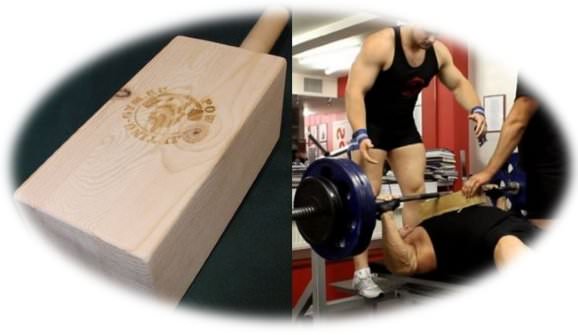
Council number 5. Lockout.
If you haven't found any handy equipment in the gym, it doesn't matter, use the bench racks for bench presses. Set them so that only the latest 10 centimeters of bench presses (until the arms are fully extended). The point is to quickly remove the neck, fully straighten the arms (without losing control of the bar) and slowly lowering the projectile onto the racks.
Council number 6. Technique "breast bridge".
Strongly bending the spine, leaving the head, shoulder blades and pelvis resting on the bench, you can more strongly include the bottom of the chest in the work. Well, since You shorten the distance, i.e. moving a heavy bar occurs at a smaller amplitude, this will allow you to spend less energy. Excess energy is directed to taking more solid weight.
The thoracic bridge looks like this (see picture).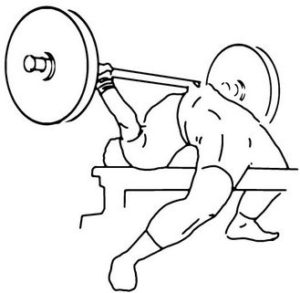
Note:
Ian King (bodybuilding coach from Australia): “the backbend is the most powerful pressing technique that can give up to 20% increase results."
"Nervous" methods:
I specifically named this group of techniques that way, because. they are all tied to the central nervous system, the brain-muscle connection and contractile fibers. For clarity, I will give the following image.

I think you remember from previous articles, in particular these ones: , that the brain is the head of everything :), because it is he who controls the entire biomechanics of raising the glands. In particular, it decides how many fibers should be shortened (take part in the work) to overcome this or that weight. In turn, the strength of muscle contraction depends on the number of simultaneously contracting fibers.
It turns out that the lifted weight depends on:
- the strength of the nerve impulse sent from the brain to the muscles (link that trains);
- on the number of fibers that simultaneously responded to the stimulus - a nerve impulse from the central nervous system;
- pain threshold perception of receptors located in the muscles / ligaments / tendons. The greater the load, the sooner they react to the ultimate stretch and the sooner they "sabotage" (do not allow) to take the required weight;
- speed (speed of contraction) muscle fibres.
In general, it turns out that we need to increase the efficiency of muscle work. This is achieved by solving two problems:
- it is required to accustom the brain (muscles) to work with large weights (pump the “brain-muscle” channel);
- you need to accustom the muscles to the speed of contraction.
The following tips will easily help you solve these “nervous” tasks.
Council number 7. Static hold.
Perform a “static” bench press and barbell hold. The first exercise is performed with weight 60-70% from a one-time maximum and consists in smoothly lowering the weight (per 15-20 seconds). After this time and after touching the chest, the barbell is powerfully squeezed up. Performed 3 approach to 3-5 repetitions.
The second exercise - take the weight 110-115% by RM (one-time maximum) and hold the bar for 10 seconds at the very top of the trajectory. Performed 3 approach (under the supervision of a safety partner). You can also hold the weight not at the extreme points of the trajectory, but in the dead positions of your specific bench press, i.e. the places where you most often have “gags” (can't squeeze by yourself).
Tip #8. Incomplete range.
Another effective method can be a bench press in an incomplete amplitude. To do this, take a little more weight (by 2-5 kg) from maximum to 6-8 times and is performed on 3-4 repetitions in 3 approaches. bottom point - 2-5 cm from the border of the pectoral muscles. The partner must be insured.
Tip #9. Singles (single repetitions).
Set the boom to the maximum (or 95% ) weight per rep. Complete 3-4 approach to 1 repetition. The recovery phase after singles is 5-7 days, so you need to resort to this method no more often 2 once a month.
Tip number 10. Speed training.
To develop the speed qualities of muscles (their ability to shrink quickly), you need to work with weight 50-60% from RM and perform 3 approach for the maximum number of repetitions. Rest between sets 1-2 minutes.
“Everything to the heap” methods:
There are also some training chips that will help you press more effectively. For example, these include:
Tip #11. Live on the floor.
Lie on the floor and do a normal dumbbell press (the technique is the same as if you are on a horizontal bench). Lowering the dumbbells occurs until the elbows touch the floor. At the top, the arms are fully extended. Complete 3 approach with weight on 8-12 repetitions.
Tip #12. negative replays.
Pick up the weight of the barbell more than your classic (with whom you most often work in training). The initial phase of the movement - the neck is held on fully extended arms. Slowly and under control begin to lower the bar down, constantly resisting the weight. The path from top to bottom should be about 5 seconds. As soon as you touch your chest, squeeze the projectile up, with the help of a partner. Complete 2-3 approach to 8 repetitions.
Tip #13. Strong grip.
In order to properly remove and transfer the power of the chest, deltoids and arms to the neck, it is necessary to firmly fix the barbell closer to the wrists. Squeeze the bar as if you want to leave your fingerprints on it.
Tip #14. Breathing technique.
We all know perfectly well that a weightlifting belt helps to add a couple of kilograms in basic exercises. This happens due to an increase in intra-abdominal pressure by squeezing the belt at the waist. So, holding your breath at a critical moment, you can increase your bench presses. In particular, the breathing process will look like this: when lowering the weight - a deep breath; when changing the direction of movement - holding the breath until the moment of overcoming the "dead" point; powerful breath.
Tip #15. Maximum momentum at the bottom of the trajectory.
In order to move the weight off the dead center, it is necessary to set sufficient momentum from the very beginning (lowering phase) (moving speed) projectile. As soon as the weight has reached the bottom of the chest, immediately powerfully (with the combined effort of all the “press” muscles) push it up. Don't stop and don't slow down (even if the bar slows down) until you pass the dead point.
Tip #16. Warming up is a way of “conservation” of energy.
Before performing the bench press, it is important to warm up the muscle groups involved in the work. In addition, it is necessary to “fire up” the body and accumulate (accumulate) as much energy as possible. Excessively long warm-ups and lead-up sets can deplete your reserves very quickly. Therefore, consider this and “do not overdo it” with her.
Tip #17. progressive resistance.
Constantly increase the demand - the demand from your muscles, i.e. try to increase the weight at least a little on every workout. If you have experienced all sorts of methods for increasing the load, then try to do one repetition more.
Tip #18. Mental concentration and creative visualization.
The right "combat" attitude is of great importance. It's the man in his brain (even before approaching the projectile) decides whether he will take this weight or not. Scroll positive images of weight gain in your head and your brain will have no choice but to follow your glitches :). Tune in to taking the next bench mark as a game with a happy ending. Say to yourself: “this is a light weight”, “I can handle it without question”. And after the approach, you will be surprised that it will be so!
Well, actually, the last piece of advice, it turned out to be a whole mini-encyclopedia. Well, let's sum up all this boltology.
Afterword
Today we answered the question - how to increase the bench press? There were quite a lot of tips, which means that now you have an order of magnitude more tools for overcoming the “bench plateau” and, as a result, transforming your own body.
Once again, re-read everything, choose the chips you like and feel free to blow into the hall to try them out in practice. And may you constantly submit to more and more new weights!
Keep in touch, good luck!
PS. If you have questions, wishes and other miscellaneous things, comments are at your service, and we don’t pass by beautiful buttons, for whom did I make them? :)
With respect and gratitude, Dmitry Protasov.


